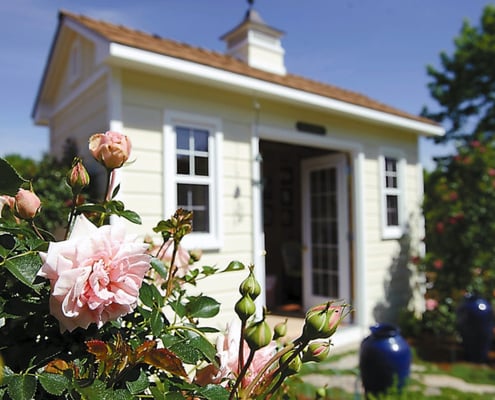Charlotte Owendyk knew just what she wanted.
A member of four local garden clubs, she envisioned a little garden-house hideaway where she could look out over her Roseville, Calif., backyard as she planned garden projects – or daydreamed.
“I always knew I wanted one, but with kids in college, we couldn’t afford it,” Owendyk said. “I bought the cupola and (tulip) weathervane 10 years ago, and they just sat in a box in our garage.”
Last year, Owendyk got her wish. Recently retired, she ordered a prefab Summerwood kit from Canada online. Once it arrived, the kit took three days for a crew to assemble, and her “Tulip House” was born.
“In a way, it’s a glorified tool shed. But I can bring my portable computer out here and write,” she said.
Extending living “room” into the great outdoors is a popular trend, particularly in fair-weathered parts of the country. Such garden structures are a way to add some special space with personality – as well as extra storage. For structures smaller than 100 square feet, they usually don’t need special building permits – just a flat slab. (But check with your city before starting.)
“Adding structure to your outdoor life can help erase the boundaries between the outside and inside of your home and make your outdoor areas the family’s favorite – and healthiest – place to be together,” said Paul Ambrose of Garden.com.
That structure may be a playhouse – designed for children or grownups. Or it may be a cabana by the pool or a garden “shed” with everything a gardener needs, including space for a library, sink, electricity and computer access.
Besides usefulness, such outdoor structures also provide an attractive focal point while making a personal statement, Ambrose said. Gazebos and pergolas are prime examples of such focal points.
Author and TV assistant director Annie Spiegelman, the “Dirt Diva,” turned her garden shed into her garden office. She took out the lawn mower and moved in her computer.
“This shed is my escape from the world,” Spiegelman said, noting that it’s surrounded by her organic garden, a massive redwood tree and climbing roses. “I feel really lucky.”
To her 14-by-6-foot Tulip House, Owendyk added a plain hutch, giving her space for books and seeds; she decorated it with Dutch-made floral decals designed for china. For tools, she hung an heirloom oak coat rack from Holland. She personalized the walls with favorite garden-themed photographs. French doors, windows and skylights fill the house with natural light.
Toronto-based Summerwood Products, the maker of Owendyk’s Tulip House, has seen its structures become garden sheds, cabanas, weekend cabins, workshops, home offices, playhouses, gazebos, garages and spas. It sells ready-to-assemble kits as well as computerized drawings. (Owendyk spent about $7,000 on hers.)
Summerwood’s most popular designs are the gable-roofed Palmerton (like Owendyk’s), a California-inspired Sonoma pool cabana and the five-sided Catalina garden house/cabana. Prices start at $2,500.
Tuff Shed, the nation’s leading maker of installed storage buildings, has been making sturdy sheds for 30 years. It annually installs more than 50,000 nationwide. But the Denver-based company now also offers designs that look like mini-ranch houses, barns, gazebos and other specialty buildings.
“Forty percent are used for storage of lawn and garden equipment,” said Phil Worth, Tuff Sheds’ national spokesman. “But we’ve definitely seen growth of more creative uses. At least 10 percent are used for nonstorage. … We’re seeing more and more and more.”
That category includes cabanas and home offices but also guesthouses and fishing lodges. Many buyers use them for pet shelters – from chickens to llamas – or hobby space, such as an artist studio. The basic Garden Ranch model starts at about $1,200.
And, yes, people live in them, too.
“Honestly, they do,” said Summerwood’s Brandon Ruck. “A lady in Hawaii bought one of our 12-by-12(-foot) structures and she lives in it year-round. It’s next to a waterfall.”
Owendyk doesn’t live in the Tulip House, although she spends nearly every morning at its desk – and some evenings, too.
“This is my dream,” she said. “It took a lot of years before I could make it happen. Sometimes, anticipation makes things better. With this house, the long wait made it special.”
To see the full product offerings of Tuff Shed, click here.







OMG! Thats just what I want but a bit smaller!
Liz,
Thanks for reading our blog! Have you designed your dream building through our Build-a-Quote page yet? If not, we recommend you check it out.
Build-a-Quote page: http://tuffshed.wpengine.com/quote/
Thanks,
Tuff Shed